Key takeaways:
- Community housing development focuses on creating connections and a sense of belonging among residents, rather than just providing shelter.
- Effective fundraising is crucial for the success of community housing projects, emphasizing the importance of relationships and storytelling to engage donors.
- Collaborative efforts and local partnerships can enhance fundraising outcomes and foster innovative solutions within the community.
- Clear goals, personal stories, and gratitude in follow-up communications are vital for fostering long-term support from contributors.
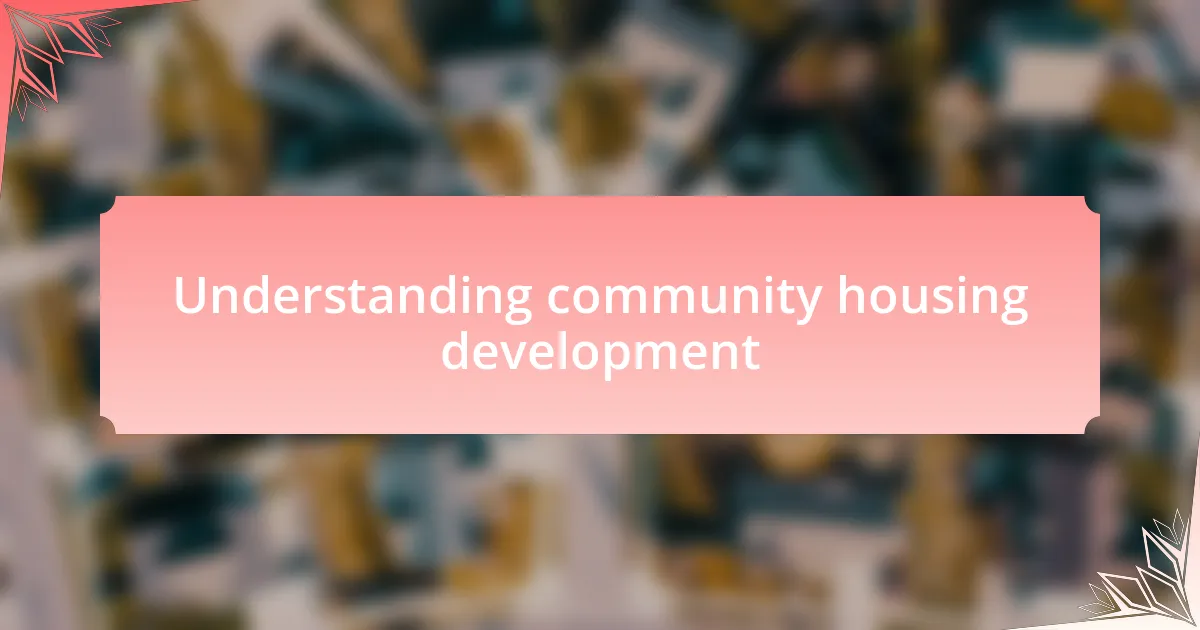
Understanding community housing development
Community housing development is about more than just constructing buildings; it’s about creating a sense of belonging. I remember visiting a community housing project where the residents spoke passionately about how these spaces transformed their lives. It struck me that it wasn’t just shelter they were seeking, but connection, stability, and a unified community.
Often, community housing initiatives are tailored to meet the unique needs of the residents, reflecting their culture and aspirations. Have you ever thought about how a space can influence the way people interact? I’ve seen firsthand how inclusive designs foster collaboration and friendships among residents. It’s fascinating to realize that a well-planned community can lead to social networks flourishing organically.
The process of community housing development also relies heavily on engaging with residents at every stage. I cannot stress enough how pivotal it is to listen to their voices. When you involve people in the decision-making, you’re not just developing housing; you’re empowering individuals to take ownership of their future. This collaboration often leads to sustainable solutions that resonate on a deeper level.
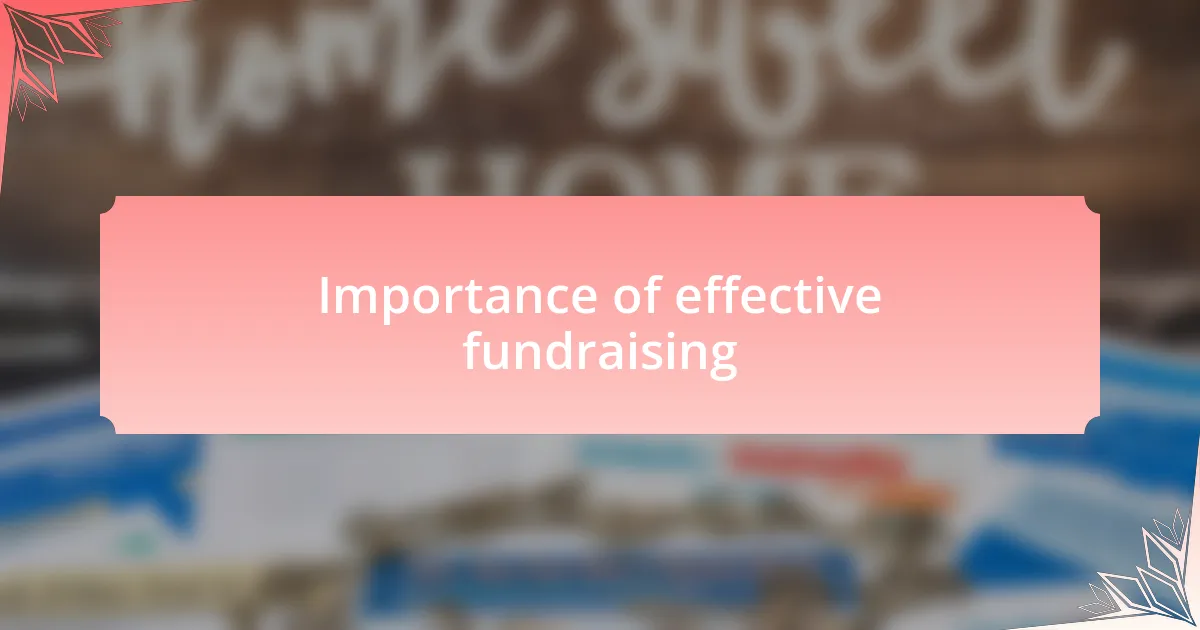
Importance of effective fundraising
Effective fundraising is the backbone of successful community housing projects. I recall a time when a lack of adequate funding stalled an incredible initiative aimed at revitalizing an underserved neighborhood. That experience taught me that without proper resources, even the most promising projects can falter, losing vital momentum and community support.
Moreover, fundraising isn’t just about gathering money; it’s about building relationships and awareness. When I’ve reached out to potential donors, I’ve always emphasized the real stories behind our projects – the families who are uplifted, the lives transformed. It’s fascinating how sharing these narratives can resonate with people, prompting them to contribute beyond mere financial support. Have you ever felt moved enough by a cause to lend your voice or resources? That’s the essence of effective fundraising.
At its core, effective fundraising can create a ripple effect of positive change. I remember witnessing the excitement in the community when we secured a significant donation; it wasn’t merely about the funds, but the hope and validation that our cause mattered. That moment illustrated how successful fundraising can ignite passion, inspire action, and encourage community members to come together for a shared vision. It’s powerful to think about how lives can be transformed, not just through the buildings we create, but by the collaborative spirit fostered through successful fundraising efforts.
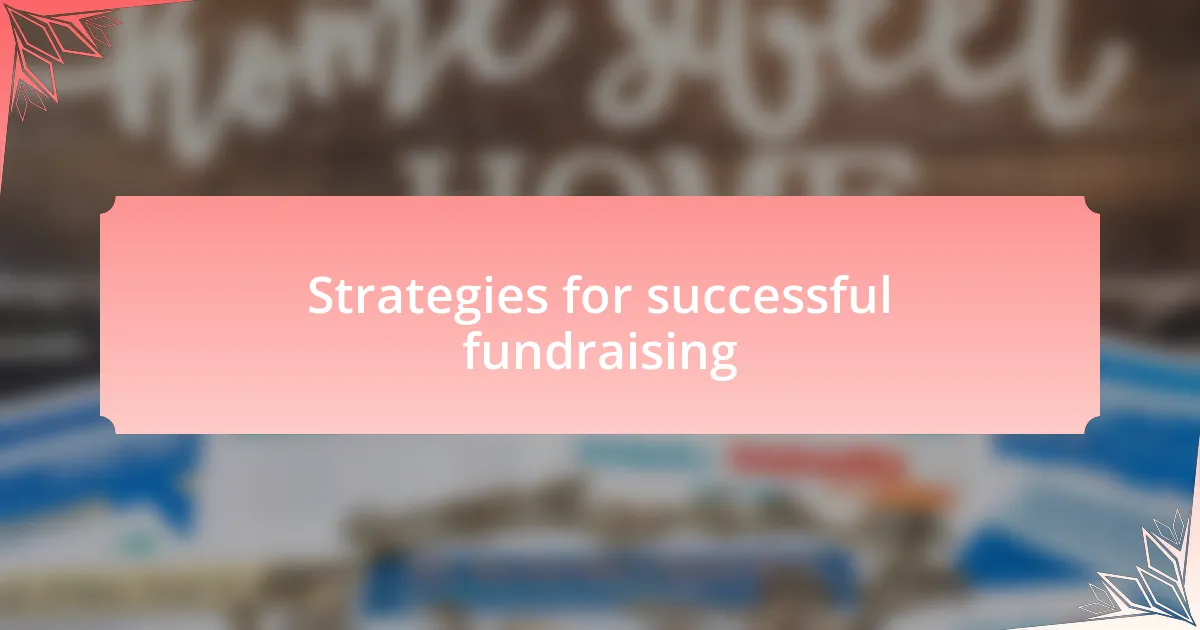
Strategies for successful fundraising
One of the most effective strategies I’ve found in fundraising is creating engaging events that connect people to the cause. I once organized a community dinner where local chefs donated their time, transforming a simple meal into a fundraiser. The atmosphere was electric, filled with laughter and stories shared around the table, which I believe ignited a passion for our project that mere flyers could never achieve. Have you ever noticed how personal involvement can shift perspectives?
Building a compelling narrative around your mission also plays a crucial role. I remember when I crafted a presentation highlighting a family’s journey from housing insecurity to stability through our project. The emotional weight of their story evoked genuine empathy, resulting in numerous pledges from attendees who felt directly connected to the cause. It struck me how essential it is to put a face to the mission; people want to contribute to what they can emotionally relate to.
Regular communication with donors nurtures lasting relationships and keeps your cause at the forefront of their minds. After each fundraising campaign, I make it a point to send personalized thank-you notes and updates on the impact of their contributions. This practice has always generated a sense of ownership among donors, making them more likely to support us in the future. When was the last time you felt genuinely appreciated for your contribution? That moment of recognition can be deeply rewarding and encourages continued support.
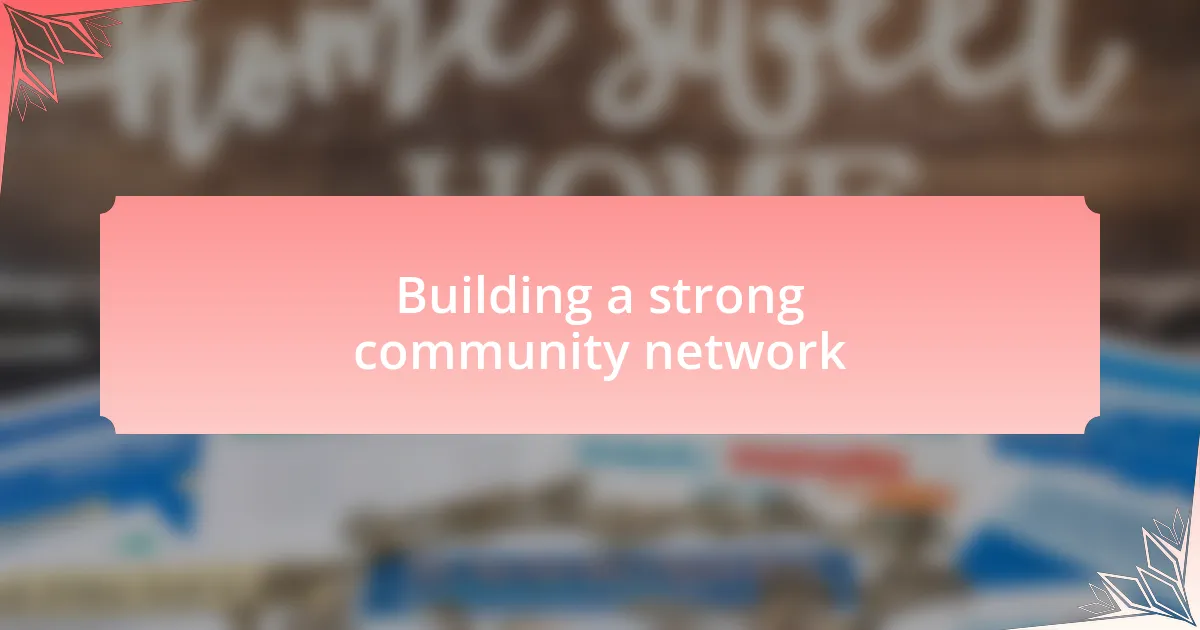
Building a strong community network
Building a strong community network starts with forging genuine connections. I once attended a neighborhood meeting where residents shared their concerns and hopes for our community. Listening to their stories created an immediate bond—I realized that we all shared the same vision for a better future. Have you ever experienced that moment when a shared story transforms a group of strangers into allies?
Engaging local businesses in our mission has been mutually beneficial. I recall approaching a nearby café owner to host monthly coffee chats focused on housing development. The café not only drew in a diverse group of residents but also allowed the owner to demonstrate his commitment to community well-being. This synergy fostered trust and showed how collective efforts can amplify our voices.
Finally, I’ve found that actively involving community members in decision-making strengthens our network. During one local project, we held brainstorming sessions where everyone—from families to local leaders—could contribute ideas. Witnessing their excitement as they saw their input shape our plans was profound. Doesn’t it feel empowering to know that your voice matters in shaping the community you live in?
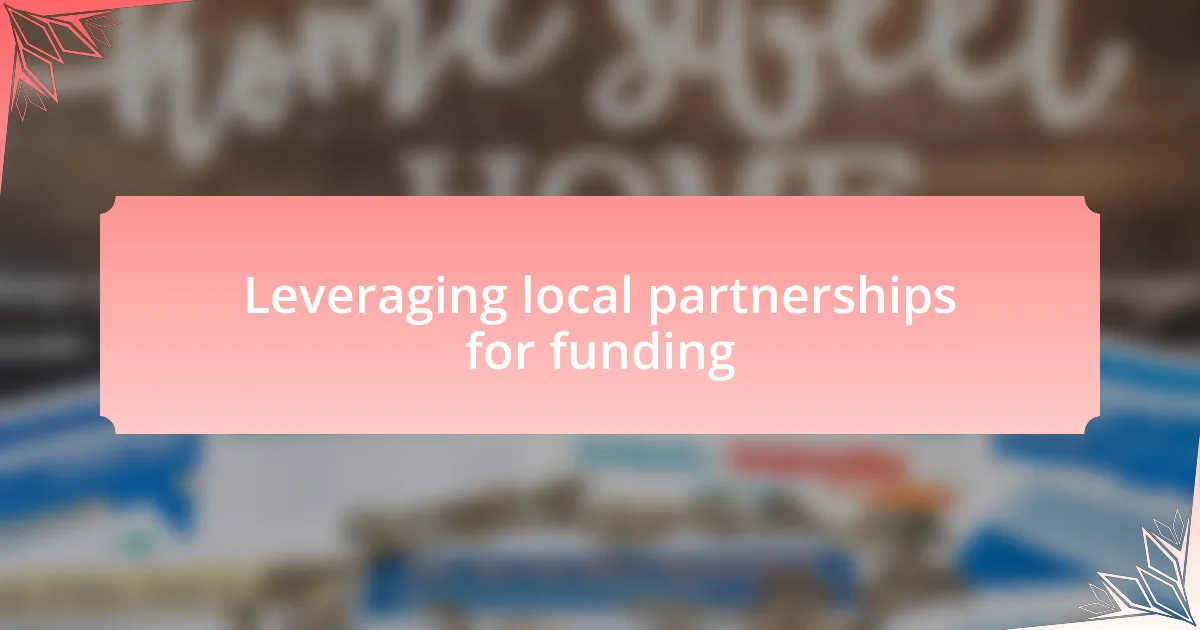
Leveraging local partnerships for funding
One of the most impactful strategies I’ve employed in fundraising is leveraging local partnerships. I remember partnering with a local nonprofit focused on youth empowerment for a fundraising event. By aligning our missions, we not only shared resources but also attracted a broader audience. It was incredible to see how our combined networks turned a small event into a community celebration, generating funds and awareness for both causes. Have you ever noticed how collaboration can breed unexpected opportunities?
Collaborative funding efforts can also come from unexpected places. For instance, I approached a local artist to create a mural that highlights community housing needs. In exchange for a small fee, the artist gained visibility, and we secured a portion of the proceeds from the sale of related merchandise. It underscored a crucial lesson: local partnerships can turn creative ideas into tangible funding sources while fostering artistic expression. Isn’t it fascinating how mutual benefit can spark innovation?
Moreover, I’ve discovered that cultivating long-term relationships with local organizations often leads to continued support. After working closely with a neighborhood association on a housing initiative, they chose to earmark funds from their annual fundraiser specifically for our project. This experience solidified my belief that when you invest time in nurturing relationships, you create advocates who understand the importance of your mission. Have you ever felt the power of support from someone who believes in your cause?
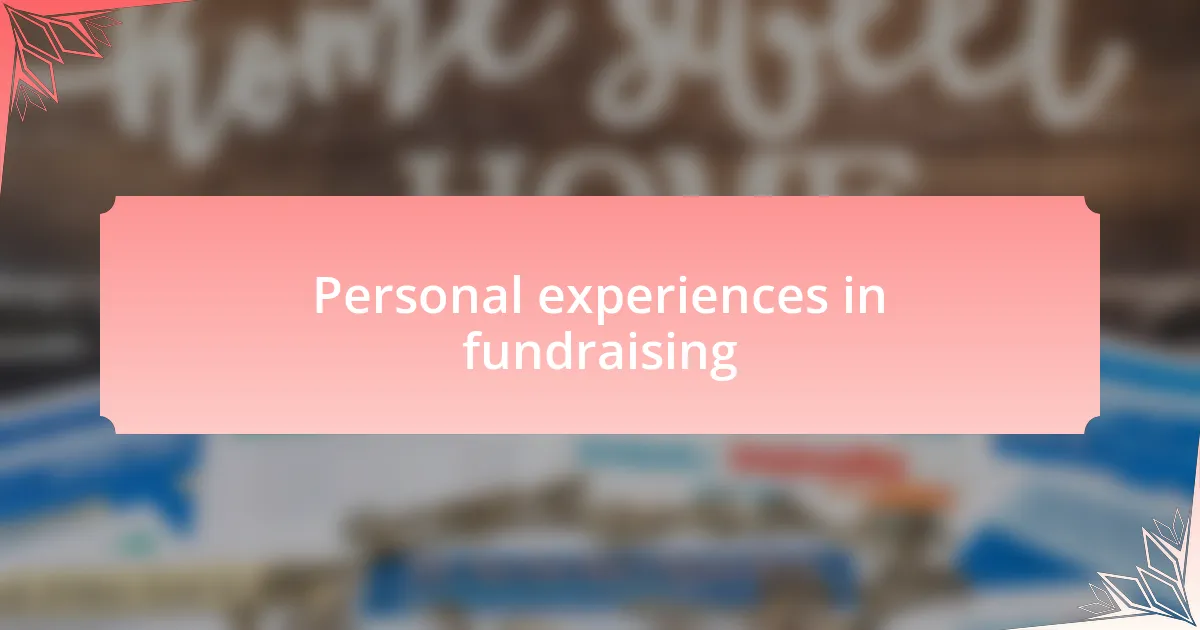
Personal experiences in fundraising
I vividly recall my first fundraising experience, which caught me off guard. I was tasked with organizing a community bake sale, and I was nervous about meeting our financial target. However, the overwhelming support from locals, each bringing their own baked goods and stories, transformed the event from a simple sale into a meaningful gathering. Have you ever felt that sense of community pride when everyone comes together for a common goal?
There was a time when I tried my hand at crowdfunding online, thinking it would be an easy win. I shared my story, but I was surprised to find that success didn’t come from just the reach of my posts. Instead, it was the personal touch that made a difference. Engaging directly with contributors, sharing updates, and expressing gratitude fostered a genuine connection that led to increased donations. Isn’t it interesting how the personal stories behind the numbers are what truly resonate with people?
One of my most rewarding experiences was organizing a charity dinner that brought together diverse community members. As I mingled with guests, many shared their own experiences with housing struggles, which deepened my resolve in our mission. This event not only raised funds but created a platform for healing and understanding, reinforcing the notion that fundraising is as much about building relationships as it is about financial support. How often do we overlook the power of shared narratives in driving our causes forward?
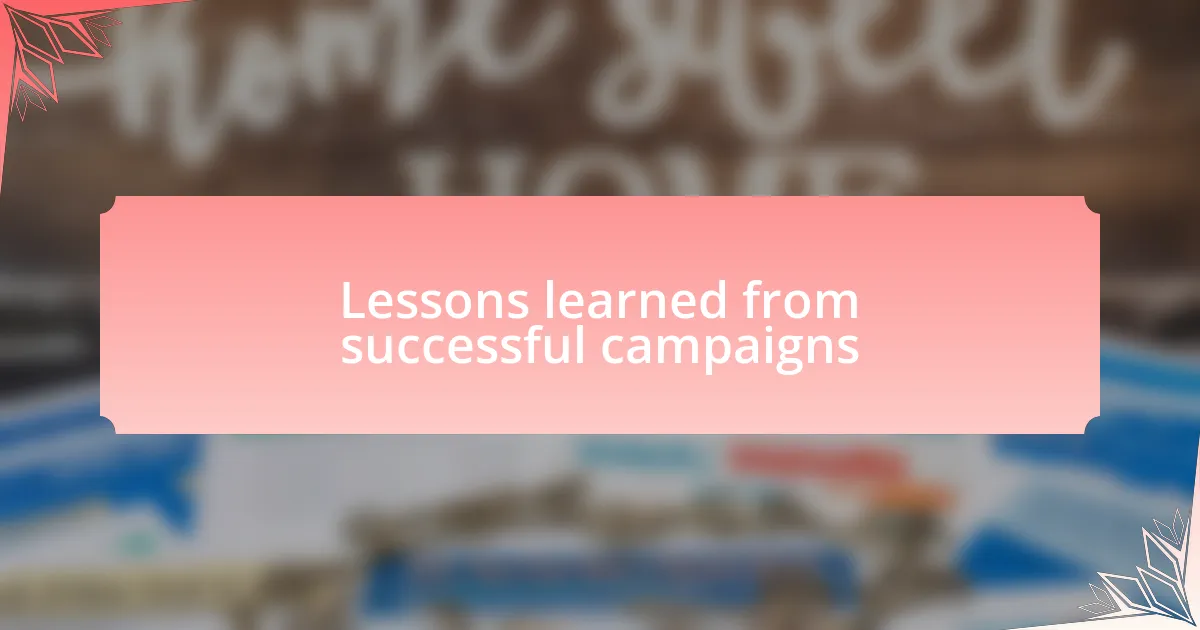
Lessons learned from successful campaigns
Reflecting on what I’ve learned from successful fundraising campaigns, one key takeaway is the importance of setting clear, relatable goals. During a neighborhood fundraising event, we aimed to raise a specific amount for community housing renovations. Knowing exactly what we were working towards united everyone, creating a sense of purpose that motivated both volunteers and donors. Have you ever noticed how clear objectives can rally even those who may initially feel disconnected?
Another lesson that stands out for me is the impact of storytelling. In a recent campaign, we integrated personal stories from families who benefited from our housing initiatives. These heartfelt narratives not only engaged our supporters but also cultivated empathy and a deeper understanding of our mission. It’s fascinating how a simple story can shift perceptions and build lasting connections, isn’t it?
Finally, I’ve learned that follow-up is crucial. After a successful event, I made it a point to reach out to each contributor with a heartfelt thank-you message and updates on how their donations were making a difference. This not only acknowledged their generosity but also reinforced their commitment to our cause. Don’t you find it powerful how a small gesture like gratitude can transform one-time supporters into lifelong advocates?